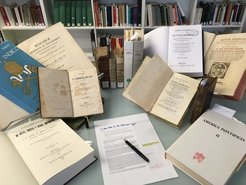Weaving a historiographical tapestry of Spanish Patronato Regio and Portuguese Padroado
Forschungsprojekt

To trace the framework of the historiography about the Patronato Regio, encompassing investigations on history and legal history, is a crucial step in the process of proposing new research perspectives. Such step, however, may reveal itself a complex challenge in the case of Patronato.
There are several reasons for this situation:
First, Patronato does not present itself as a simple, unitary institution. In fact, it comprises a wide range of legal activities performed by the Spanish Crown regarding ecclesiastical institutions in its territories, such as the nomination of bishops, the definition of diocesan geographical limits, the control over the effectiveness of papal bulls and briefs, and even the exercise of jurisdiction, as an instance of appeal to the local clergy.
Furthermore, Patronato was not exclusively circumscribed to the spatial and temporal boundaries of the early modern Spanish Empire. In fact, it was a rather common practice in European territory since the Middle Ages; one by means of which the relations between many monarchies and the papacy developed.
During early modernity, the Portuguese Empire also established its own Patronato system. In both cases, Spain and Portugal, along with the east- and western Iberian colonies, experienced it in different ways, depending on a variety of factors, from environmental conditions to evangelization and settlement methods and goals. Moreover, different developments of this legal regime can be tracked over time, enabling us to see it adapt to imperial as well as republican schemes in the context of the independence of Ibero-American colonies in the 19th century, not to mention the multiple secularizing reactions against the Patronato system that followed.
Finally, due to the involvement of different actors and different kinds of sources, the Patronato is a phenomenon that can be observed from many different perspectives. A significant part of historiography, deemed traditional, has considered Patronato as a closed system in which the crown and local churches played leading roles, leaving very little room for the papacy and the Roman Curia to interact. As if after the pontifical concession of Patronato rights and the issuance of the correspondent bulls during the 15th and 16th centuries, the Holy See had ceased to exercise jurisdiction over Iberian territories.
Recently, however, researchers working on the history of the Papacy and the Roman Curia have cast doubt on the totalizing, adamantine, character of Patronato by exploring the records of activities and decisions made by Roman actors regarding Ibero-American issues. Among these actors, the most active have been the apostolic nuncios, the secretary of state and the cardinal congregation. By comparing and cross-referencing Vatican and local sources, these studies begin to reveal the role played by the Holy See in the Ibero-American territory. Moreover, they contribute to an interpretation of Patronato as a system that permits the coexistence – although not without conflict – of multiple actors who performed tasks that resonated at the local and global levels.
In order to address Patronato Regio in its various facets, in a way that is fully coherent with the research project and offers a new look at the Patronato Regio, the Roman Curia and the government of the Ibero-American church in the Early Modern Period, we propose a catalog of scientific publications on the subject. This catalog will begin with a thorough review of books, chapters and articles from the following main areas: history of law, in particular of Derecho Indiano, the history of the Ibero-American Church, and the history of the Papacy and the Roman Curia.
Even though they had little reciprocal influence, these three historiographical traditions developed perspectives that are complimentary. By gathering together findings and interpretations from these three areas, we hope to grasp Patronato in its multitude of configurations, experiences, developments and perspectives, in order to approach it as a phenomenon that involves the Holy See, local churches and the Iberian crowns simultaneously in an interwoven and complex relationship.
- Tejiendo un tapiz historiográfico sobre el Patronato Regio español y el Padroado portugués (ES) 308.1 kB
- Tecendo uma tapeçaria historiográfica sobre o Patronato Régio espanhol e o Padroado português (PT) 307.72 kB
